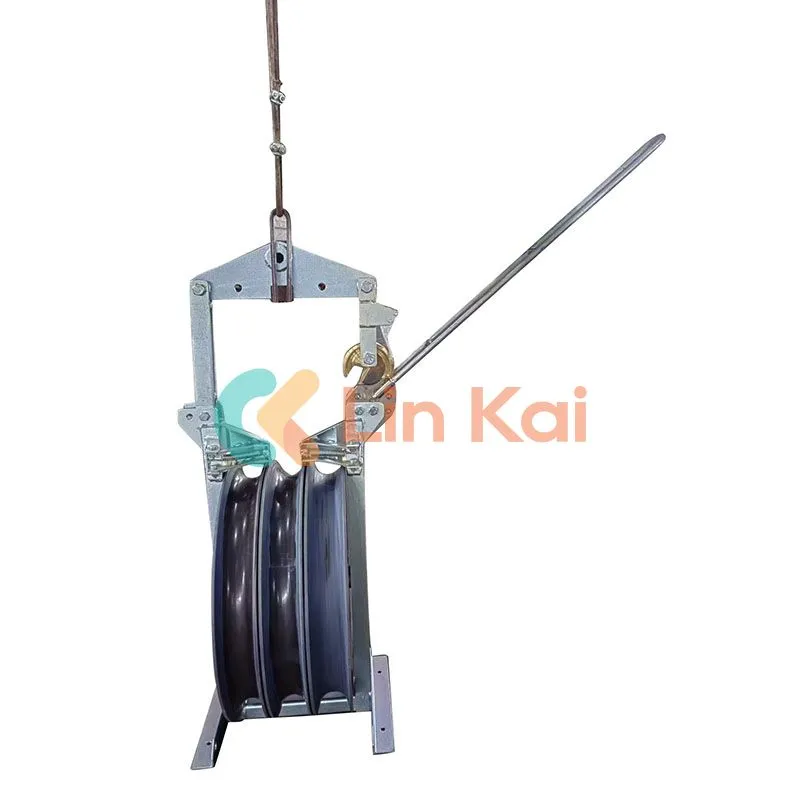What are the different types of Stringing Blocks available?
2024-11-12
Stringing blocks come in various types, each designed to address specific needs during the installation of overhead cables, such as high-voltage power lines and communication lines. They vary by size, materials, design, and application, offering different ways to accommodate cables and minimize friction. Here are some common types of stringing blocks and their uses:

1. Single Sheave Stringing Block
- Description: This is the most basic type, featuring a single wheel or sheave for the cable to run over.
- Use: Ideal for straight-line cable runs, where the cable only needs to be pulled over short distances or around small curves.
- Advantages: Simple, lightweight, and easy to install, making it a popular choice for many standard installations.
2. Double Sheave Stringing Block
- Description: Equipped with two parallel wheels or sheaves, allowing two cables to be pulled simultaneously.
- Use: Commonly used in installations where multiple cables (such as paired or twin cables) need to be run together.
- Advantages: Reduces time and effort when pulling more than one cable, as it maintains separation and reduces friction for each line.
3. Three Sheave and Multi-Sheave Stringing Block
- Description: Features three or more sheaves, allowing multiple cables to run through a single block.
- Use: Typically used in complex installations where three-phase power or multiple lines need to be pulled in tandem.
- Advantages: Keeps multiple cables organized and prevents entanglement, offering an efficient solution for multi-line installations.
4. Angle or Corner Stringing Block
- Description: Designed with specific angles or swiveling sheaves to accommodate directional changes in the cable path.
- Use: Used on poles or towers where the cable route requires a sharp turn or change in direction.
- Advantages: Reduces friction by guiding cables smoothly around corners, decreasing the risk of wear or damage from bending stress.
5. Bundle Conductor Stringing Block
- Description: A larger block with multiple sheaves or separated tracks to handle bundled conductors (multiple conductors grouped together).
- Use: Ideal for high-voltage transmission lines with bundle conductors, such as double or triple conductor setups.
- Advantages: Maintains the required spacing between conductors to prevent tangling, minimize electrical interference, and reduce overall friction.
6. Helicopter Stringing Block
- Description: Specifically designed for use in helicopter-aided installations, which are common in remote or hard-to-access areas.
- Use: Used when cables need to be strung by helicopter, typically in challenging terrain or over long distances.
- Advantages: Lightweight and durable, with a special design to allow quick attachment and release from helicopters for efficient overhead line installation.
7. Universal or Swivel Stringing Block
- Description: A versatile block with a swiveling attachment, allowing it to pivot and adjust to different angles.
- Use: Useful in installations where the alignment may shift or in situations with multiple directional changes.
- Advantages: Provides flexibility and adaptability, minimizing the need to reposition the block as the cable path changes direction.
8. Nylon Stringing Block
- Description: A block made with a nylon sheave instead of metal, known for its lightweight and low-friction properties.
- Use: Often used for lighter cables or in installations where lower friction is critical, such as fiber optic installations.
- Advantages: The nylon material reduces friction, is gentler on cables, and is generally more affordable and easier to handle.
9. Heavy-Duty Stringing Block
- Description: Built with reinforced frames and larger sheaves, designed to handle very heavy or high-tension cables.
- Use: Used for large-diameter power lines and cables with higher weight and tension, common in utility-scale installations.
- Advantages: Provides durability and stability for heavy-duty applications, ensuring safe handling of high-tension loads without deformation.
10. Ground Stringing Block
- Description: Specifically designed for installations where cables are pulled at ground level rather than aerially.
- Use: Suitable for laying cables across flat terrain or for underground installations.
- Advantages: Prevents cables from dragging along the ground, reducing abrasion and protecting the cable’s outer sheath from damage.
Summary
Each type of stringing block is suited for particular installation needs, whether it's for handling multiple lines, adapting to directional changes, working in high-tension environments, or facilitating helicopter operations. Selecting the right stringing block helps ensure a smooth, efficient cable installation, protects the cable from friction and damage, and accommodates the unique demands of each project.


